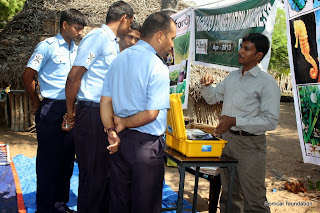Conservation Benefits Community
Any kind of
coastal ecosystem restoration can be successful, only if it can support
sustainable livelihood of local community by potentially contributing.
Our pilot mangrove restoration sites have proved that crab population increased
with the increase of mangrove cover in restoration sites. However, not
all our coastal community in Palk Bay directly depends on mangrove associated
fishery along the coast. Mangrove assoicated fishery is more common in
the villages around Muthupet Mangrove Reserve forest.
There is a small population of tribal community
living adjacent to our mangrove restoration site, have been catching mangrove
crabs, shrimps and fishes. They have no complex, expensive fishing gears
and crafts. Both men and women do fishing in creeks and mangrove swamp.
Women used to sit in the muddy mangrove waters to catch shrimps by hands,
while men dig pit to catch crabs. Similarly people living in the villages
behind the coastal area, used to visit the mangroves and salt marsh lands to catch
crabs.
After a few years of developing our pilot mangrove restoration sites, our sites
now become one of the favorite place for crab catchers, who some
times break our fences. However, we do appreciate to catch crabs from
our restoration sites, without damaging mangroves and seedlings.
Some info about crabs from wikipedia...
Mangrove crabs are crabs that live among mangroves, and may
belong to many different species and even families. They have
been shown to be ecologically significant in many ways. They keep
much of the energy within the forest by burying and consuming leaf
litter. Along with burrowing in the ground, this crustacean can climb trees to
protect itself. The Hermit crab and the Mangrove crab are the only crustaceans
that can climb trees as a defense mechanism. Furthermore, their feces may
form the basis of a coprophagous food chain contributing to mangrove
secondary production. Mangrove crab larvae are the major source
of food for juvenile fish inhabiting the adjacent waterways, indicating
that crabs also help nearshore fisheries.
In OMCAR restoration sites, we have conducted a study to count the number of
crab holes using transects. Our study proved that number of crab holes
were abundant adjacent to mangrove trees and under their canopy, and species of
crabs are also different between mangrove and non mangrove area.
Scylla
serrata (mud crab) is one of the highly valued product in international market,
that provides a good economic support to small scale fishers living around mangroves.
This crab is called as thillai nandu or samba nandu in Tamil. This
crab has a dark green coloured shell, to hide itself behind mangroves.






























